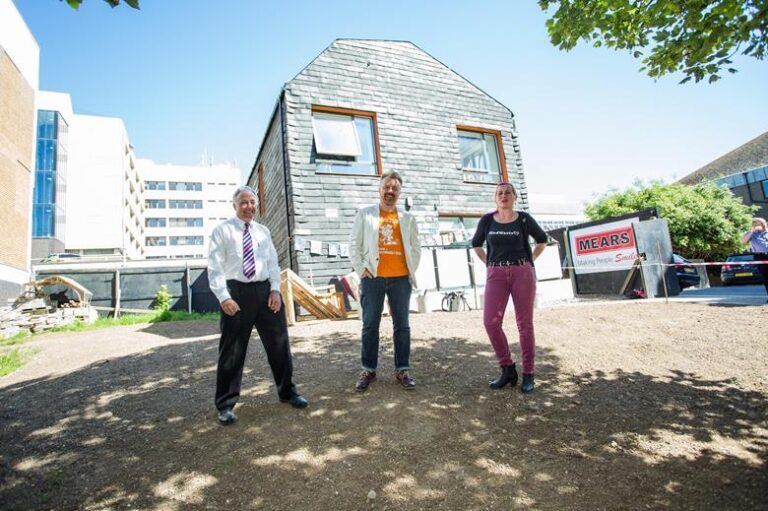Journal: 2nd July 2024
Are you like a rabbit caught in the headlights when it comes to the design of low carbon buildings?
Duncan Baker-Brown on how to embrace sustainable practices, reduce material consumption, and help drive the transition to a circular economy
One of the many benefits of working in practice, teaching, and research during the same week is that my work often requires me to travel around the UK and much of Europe. I often get the opportunity to meet hundreds of people in the construction industry who are making strides toward what we might describe as a ‘climate literate’ built environment – one that understands some of the complexities of the climate and ecological emergency and then acts accordingly.
However, perhaps more often, I meet people who, quite understandably, feel completely overwhelmed by the existential crisis and the multivarious ‘solutions’ to this problem. These solutions are often packaged as an “if you just choose CLT, stone, hemp, earth, low carbon concrete, etc.” singular solution. Well, all the above could be just what you need, or not – it all depends. If you are one of these people, then you might want to read on.
What I want to do with this ‘op-ed’ is to try and help you navigate the increasingly complicated world of extremely well-meaning guides to low (whole life) carbon/sustainable/closed loop/circular and, of course, regenerative design solutions. There are just so many of them, and they often appear to contradict each other. And so I can declare that even though it’s my subject area, I can get confused as well.
To counteract this, I try to keep my ambitions clear. To cut to the chase, my position is simple – the best solution is the one that consumes the least amount of material, destroys the least amount of natural habitat, employs the least amount of child and/or slave labour, whilst ideally creating delightful, healthy, accessible, safe, and low carbon places that simultaneously enable the regeneration of natural systems. But how does one achieve this?
The first thing to do is work out where you are placed on planet Earth. Although there are some universal truths when considering a positive impact on the climate and ecological emergency, there is no getting away from the fact that the ‘Global North,’ and the UK in particular, has had the most benefit (over the last two hundred years or so) from extracting vast amounts of raw materials from across the planet whilst burning copious amounts of fossil fuels.
"It’s therefore not at all surprising to discover that our industry, the construction sector, consumes about 50% of all raw materials harvested every year"
According to the Royal Society, the industrialisation of the Global North over the past two centuries has generated 92% of the human-induced greenhouse gas emissions that contribute so effectively towards advancing climate change. So, I am writing this article as a citizen of the Global North and, in particular, as a citizen from the UK, where I practice as an architect.
Now that is clear, let’s deal with the scary stuff – the bad news, as it were. In 2012, the Circular Gap Report (published by Circle Economy Foundation) stated that humans consumed between 45-60 billion tonnes of raw material every year. A similar report published in 2022 stated that this figure had more than doubled to somewhere between 125-135 billion tonnes of raw materials consumed by humans annually.
These figures are, of course, incomprehensible. I only quote them because the relative figures show a doubling of consumption in just 10 years, which is worrying but understandable when one considers that predictions of the super-fast urbanisation of our landscape are based upon building a city the size of Paris every week. It’s therefore not at all surprising to discover that our industry, the construction sector, consumes about 50% of all raw materials harvested every year.
In the UK, it creates about 63% of the 200 million tonnes of waste going to landfill and incineration every year. The UK construction industry appears particularly wasteful when you compare this with the 35-45% figure from European countries.
There’s no getting away with it – the construction sector is having a massive negative effect on biodiversity and the destruction of our natural systems. If you also consider that the design, construction, occupation, maintenance, and demolition of the built environment contributes over 45% of the UK’s total CO2e emissions, then it is not too rash a statement to say that the construction sector is half the problem causing the current mass extinction of species and the climate catastrophe.
OK, that was a bit scary. What about some good news? Well, I heard this statistic at an RIBA conference a couple of years ago: “If you design a 10m x 10m concrete slab 50mm thinner than normal, you will save as much CO2e as not eating meat for one year!” Our industry can be a massive force for good if only we could work out how to dramatically reduce the amount of new stuff required to develop our built environment. And so, I will proffer in this article one big point to take away with you: we (humans) need to work out how to responsibly manage planet Earth’s resources to ensure our survival.
In particular, I would argue that it is the particular responsibility of architects, designers, constructors, and manufacturers that do this for a living. We specify what things are made of, how much new material we need, and where it should be made. Moving forward, we now need to make ourselves aware of the real consequences associated with the specification of stuff – where it comes from, how effective it is to use, and what happens to it at the end of its ‘life’.
It’s all about managing resources and dramatically reducing the need to consume new raw materials. This point is now making much more sense to many more people across the whole of the planet because resource security is now a thing of the past. By steering our construction projects away from a reliance on new products and materials made from ever more difficult-to-find raw materials, we will reduce the burden on the natural world to provide these resources.
Leave the natural world alone for a bit, and it will start to heal and replenish. If you look back to the first COVID-19 induced lockdown, you will remember how quickly air pollution was reduced and, perhaps more surprisingly, how quickly nature came looking for us, or more precisely, how nature was able to reoccupy the spaces left by humans who were suddenly delightfully docile.
If the global North begins to reduce its consumption of raw materials, the super unethical mining industry will begin to shrink, allowing humans and the construction sector in particular to ‘mine the anthroposphere’ instead, i.e., to re-work the previously manufactured. That is all well and good as an aspiration, but the real question is, “how do we achieve this when it is so difficult to apply the systems change required to turn the current ‘take, make and throw away’ linear economy into an authentic ‘circular economy’?”
"We have an opportunity to lead this embryonic industry"
Interestingly, this may not be as far away as many people think. In the last two years, a 10-minute ‘Carbon Emissions (Buildings) Bill’ has been presented to parliament on three occasions. It asks for amendments to the Building Regulations to include the reporting of Whole Life Carbon and limiting/benchmarking of Embodied Carbon. If/when this Bill becomes law, it will transform the construction sector overnight.
As soon as embodied carbon is quantified, limited, and benchmarked, adaptive re-use and retrofit will make a lot more sense than it does to many people today because the easiest way to reduce your embodied carbon figure in your development is to reduce the amount of new imported resources to utilise and maximise the amount of extant built fabric on site. Tax-subsidised demolition will become a thing of the past. Good news for the natural world and those of you who are well versed in adaptive re-use, creative retrofit, deconstruction, and ‘urban mining’ in general.
Although those urban miners might be gaining in number every day, most of our construction industry community is trained to build new. So, my plea to you today is that you learn how to rework the existing as soon as you can. I believe that the RIBA can be a massive help in supporting architects and their clients to upskill and meet the challenge that adaptive re-use presents us all. It can focus on shining a light on the huge opportunity that is the creative adaptation of our built environment so that it is fit for purpose, accessible, affordable to occupy, low carbon, healthy, and crucially climate resilient.
This will include highlighting best practices across the UK and beyond, whilst lobbying the government to include embodied carbon benchmarks in Building Regulations and support a stable and expanding retrofit industry. One of my main ambitions, if I get the opportunity to be the next President of RIBA, is to get the whole of our membership engaged with the massive opportunity for work that a creative and diverse approach to retrofit presents us all.
We have an opportunity to lead this embryonic industry – it would be a massive loss if we leave it to others who see it as simply applying external wall insulation and solar panels to our homes and workplaces. We need our community of architects and engineers to provide creative, diverse, cost-effective, and impactful solutions to this challenge, and it is often small practices that are already well versed in doing just this.
Meanwhile, there will be further support coming in the form of the UK Net Zero Carbon Buildings Standard, which will be published this coming autumn. This is an initiative that will provide the set of rules by which our industry will work out how to spend its meagre carbon budget – the one that meets net zero targets for 2035 and 2050. Rather impressively, it has buy-in across pretty much all significant institutions across the built environment, and because of this, I believe that it, plus the next version of the ‘Carbon Emissions (Buildings) Bill,’ will get embodied carbon included in the Building Regulations.
So, my plea to you is this: don’t be overwhelmed by the onslaught of guides to low carbon construction. Just look at ways to re-use existing stuff, whether that is a whole building or parts thereof. Or, if you can’t convince your team to keep a building, try to get them to deconstruct it instead and distribute the materials into the supply chain. And if you think that is all dreamy pie in the sky, check out how many cities or local authorities, including London, Brighton & Hove, Glasgow, and Peterborough, either have Circular Economy Route Maps or are demanding a retrofit-first approach to development. Don’t get caught in the headlights.

